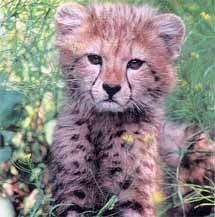cheetah
chee·tah \ˈchē-tə\
A long-legged, swift-running wild cat (Acinonyx jubatus) of Africa and southwest Asia, having tawny, black-spotted fur and nonretractile claws. The cheetah, the fastest animal on land, can run for short distances at about 96 kilometers (60 miles) per hour.
Focal Palatine Erosion
Is an oral dysfunction associated with a severe dental malocclusion discovered in captive Cheetahs, and subsequently found in some of the other large felids both in the wild and in captivity. It was first identified by Fitch & Fagan in their article published in the journal of ZOO BIOLOGY in 1982. The search for the exact etiology of this debilitating disorder has been a complex, multi-faceted and on-going quest ever since. In many respects, Cheetahs are a very unique species which have survived at least two massive die-offs in the past, and appear to be rapidly approaching a third. Their genetic diversity has been shown by O’Brien et al, to be similar to that of 100 generations of inbred lab-rat to say the least – severely depauperate. According to the International Cheetah Studbook, their numbers are rapidly approaching a critical point of no return . . . . . or “statistically irrecoverable extinction.” Many groups and individuals are involved in the search for the factors which may prevent and/or reverse this trend. The Colyer Institute has been actively involved in this process since 1982.
Following is an assortment of articles, papers, and information concerning this international investigative effort: You can view, download, and print out high-quality, graphics-enhanced versions.
- CT scan of Cheetah and Puma Skull
- Focal Palatine Erosion – Defined (PDF 51KB)
- Focal Palatine Erosion – Example
- F.P.E. Evaluation Protocol (PDF 26KB)
- The International Cheetah Studbook
- About Cheetahs
- CT-Scan Study of Cranial Material
- The Cheetah : Native American ??? (PDF 565KB)
- “Life on the Cheetah Circuit”
- Close-up View of the Cheetah’s Special Features

